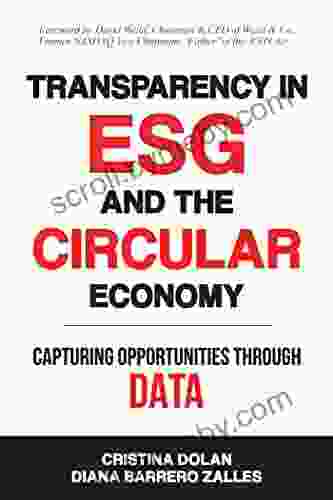Transparency in ESG and the Circular Economy: A Path to Sustainable Growth

In the face of growing environmental and social challenges, businesses are increasingly recognizing the importance of integrating environmental, social, and governance (ESG) factors into their operations. ESG transparency has become paramount, allowing stakeholders to assess a company's commitment to sustainability and its impact on the planet and its people. This article explores the crucial role of transparency in ESG and the circular economy, highlighting the benefits, challenges, and best practices for businesses seeking to embrace these transformative approaches.
ESG Transparency: A Catalyst for Sustainability
ESG transparency refers to the disclosure of information that demonstrates a company's performance in environmental, social, and governance areas. This includes metrics on greenhouse gas emissions, resource consumption, labor practices, diversity and inclusion, and corporate governance. By providing stakeholders with clear and accessible information, companies can:
4.4 out of 5
| Language | : | English |
| File size | : | 4951 KB |
| Text-to-Speech | : | Enabled |
| Screen Reader | : | Supported |
| Enhanced typesetting | : | Enabled |
| Word Wise | : | Enabled |
| Print length | : | 217 pages |
* Build Trust and Enhance Reputation: ESG transparency builds trust by demonstrating a company's commitment to sustainability and accountability. It allows stakeholders to make informed decisions based on the company's values and performance. * Attract Investors and Customers: Investors increasingly seek investments in companies with strong ESG credentials. Consumers are also more likely to patronize businesses that demonstrate their commitment to sustainability. * Improve Operational Efficiency: By tracking ESG performance, companies can identify areas for improvement, reduce risks, and enhance operational efficiency.
The Circular Economy: A Transformative Approach for Sustainability
The circular economy is a regenerative model that aims to minimize waste and pollution, and maximize resource utilization. It focuses on keeping materials in use for as long as possible, through design, innovation, and collaboration. By embracing the circular economy, businesses can:
* Reduce Environmental Impact: The circular economy reduces reliance on virgin materials, minimizes waste, and reduces greenhouse gas emissions. * Enhance Resource Security: By reusing and recycling materials, the circular economy helps ensure a secure and sustainable supply of resources. * Drive Innovation and Economic Growth: The circular economy fosters innovation in product design, business models, and technologies, leading to new opportunities for growth and job creation.
The Interplay of ESG Transparency and the Circular Economy
ESG transparency and the circular economy are intertwined and mutually reinforcing. ESG transparency provides the foundation for understanding a company's sustainability performance, while the circular economy offers practical pathways to improve that performance. By embracing ESG transparency, businesses can:
* Quantify and Report Circular Economy Impacts: ESG reporting frameworks can be used to disclose metrics related to resource consumption, waste generation, and product longevity, providing stakeholders with a clear picture of a company's circular economy initiatives. * Track Progress and Identify Improvement Areas: Regular ESG reporting allows companies to monitor their circular economy performance, identify areas for improvement, and set ambitious targets for further progress. * Communicate Commitment to Sustainability: ESG transparency enables businesses to showcase their commitment to the circular economy and its associated benefits, enhancing their reputation and credibility among stakeholders.
Challenges and Best Practices for ESG and Circular Economy Transparency
While the benefits of ESG and circular economy transparency are undeniable, businesses face challenges in implementing these approaches effectively. Some common challenges include:
* Data Availability and Quality: Collecting and analyzing ESG and circular economy data can be complex and time-consuming. * Standardization and Reporting Frameworks: There is a lack of standardized frameworks for ESG and circular economy reporting, making it difficult to compare companies' performance across industries. * Verification and Assurance: Ensuring the accuracy and reliability of ESG and circular economy data is crucial for credibility.
To overcome these challenges, businesses should adopt best practices such as:
* Stakeholder Engagement: Involve stakeholders in the development of ESG and circular economy reporting frameworks to ensure relevance and transparency. * Collaboration and Partnerships: Partner with industry groups, non-profit organizations, and government agencies to share knowledge, resources, and best practices. * Use of Technology: Leverage technology, such as data analytics software and blockchain, to enhance data collection, analysis, and reporting. * External Verification and Assurance: Seek independent verification and assurance of ESG and circular economy data to provide stakeholders with confidence in its accuracy and credibility.
Transparency in ESG and the circular economy is essential for businesses seeking to achieve sustainable growth. By embracing these transformative approaches, companies can demonstrate their commitment to sustainability, attract investors and customers, improve operational efficiency, and drive innovation. While challenges remain, adopting best practices and engaging stakeholders can help businesses overcome these hurdles and emerge as leaders in the sustainability revolution. The path to a more sustainable future lies in embracing transparency and collaboration, ensuring that ESG and the circular economy become integral to business operations for generations to come.
4.4 out of 5
| Language | : | English |
| File size | : | 4951 KB |
| Text-to-Speech | : | Enabled |
| Screen Reader | : | Supported |
| Enhanced typesetting | : | Enabled |
| Word Wise | : | Enabled |
| Print length | : | 217 pages |
Do you want to contribute by writing guest posts on this blog?
Please contact us and send us a resume of previous articles that you have written.
 Book
Book Novel
Novel Page
Page Chapter
Chapter Text
Text Story
Story Genre
Genre Reader
Reader Library
Library Paperback
Paperback E-book
E-book Magazine
Magazine Newspaper
Newspaper Paragraph
Paragraph Sentence
Sentence Bookmark
Bookmark Shelf
Shelf Glossary
Glossary Bibliography
Bibliography Foreword
Foreword Preface
Preface Synopsis
Synopsis Annotation
Annotation Footnote
Footnote Manuscript
Manuscript Scroll
Scroll Codex
Codex Tome
Tome Bestseller
Bestseller Classics
Classics Library card
Library card Narrative
Narrative Biography
Biography Autobiography
Autobiography Memoir
Memoir Reference
Reference Encyclopedia
Encyclopedia Matt Kindt
Matt Kindt Ellen Warren
Ellen Warren Colin Berry
Colin Berry Cor Van Den Heuvel
Cor Van Den Heuvel Colin Sinclair
Colin Sinclair Jak Beardsworth
Jak Beardsworth Michelle Kuei
Michelle Kuei Kazuhiro Fujitaki
Kazuhiro Fujitaki Conrad Tarte
Conrad Tarte Cynthia Williams
Cynthia Williams Julie Foudy
Julie Foudy Douglas K Smith
Douglas K Smith Cynthia Li Md
Cynthia Li Md Daniel Robb
Daniel Robb Susan Magee
Susan Magee Smauggy Universe
Smauggy Universe Hope Goins
Hope Goins Lisa Preziosi
Lisa Preziosi Clyde Fitch
Clyde Fitch Daily Language Learning
Daily Language Learning
Light bulbAdvertise smarter! Our strategic ad space ensures maximum exposure. Reserve your spot today!

 Samuel Taylor ColeridgeSecrets Of Power Trilogy Volume One: A Literary Masterpiece That Explores the...
Samuel Taylor ColeridgeSecrets Of Power Trilogy Volume One: A Literary Masterpiece That Explores the... Jorge AmadoFollow ·9.9k
Jorge AmadoFollow ·9.9k Gage HayesFollow ·10.3k
Gage HayesFollow ·10.3k Peter CarterFollow ·14.4k
Peter CarterFollow ·14.4k E.M. ForsterFollow ·2.4k
E.M. ForsterFollow ·2.4k Emilio CoxFollow ·4.9k
Emilio CoxFollow ·4.9k Norman ButlerFollow ·17.2k
Norman ButlerFollow ·17.2k Hugh BellFollow ·13.9k
Hugh BellFollow ·13.9k Harry CookFollow ·15.5k
Harry CookFollow ·15.5k

 Cruz Simmons
Cruz SimmonsUnveiling the Secrets: An Insider Guide to School Bonds...
Unlock the Power of School...

 Gil Turner
Gil TurnerRuins of Empire: Blood on the Stars - The Epic Space...
Ruins of Empire: Blood on the Stars is the...

 Allen Ginsberg
Allen GinsbergPrepare for the Ultimate Space Opera: Delve into The Last...
Embark on an...

 Anton Foster
Anton FosterUnleash Your Inner Artist: The Ultimate Guide to Oil...
Chapter 1: The...
4.4 out of 5
| Language | : | English |
| File size | : | 4951 KB |
| Text-to-Speech | : | Enabled |
| Screen Reader | : | Supported |
| Enhanced typesetting | : | Enabled |
| Word Wise | : | Enabled |
| Print length | : | 217 pages |














